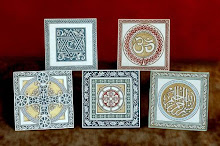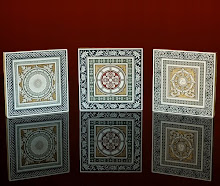 |
| My New Year's Resolution: Remain calm no matter what question I am asked. |
"Can I use this as a trivet?" I will admit to cringing the first time someone asked me that many years ago. But, it is a fair question as people look for "functionality" in what they purchase. I personally consider "art" to provide a function all its own. Our inspiration comes from the middle east where it is common to see intricately designed art tiles simply hanging on the wall or displayed on stands. So - the answer to the original question is - Yes, if you would like to use them as trivets I would suggest getting the self adhesive footies (rubber or felt) to put onto the back corners.
Selling the work that you create - makes you humble...and tough.
Another more frequent question is:
How should I display my art tiles?
There is a slanted slot inset into the back of each piece.
To hang: Use a flat head nail or screw. The flat head of the nail or screw gives enough of a lip for the slot to fit right over and allow the tile to securely hang flush to the wall.
Extra security wanted? Use the nail or screw BUT ADD a piece of double stick velcro to the bottom back of the tile and wall. 3M Command Products are advertised as not damaging to your walls. Remember: These mounting strips ARE NOT bearing the entire weight of the tile. The nail or screw is doing that. What the mounting strip does is stabilize the bottom of the tile for added security if the tile is hit, the wall is banged on or the door near to it is slammed. Remind me sometime to tell you the story of how a Hamsa went flying across the yard.
OR - just find a simple stand and display them on a table, shelf, desk or mantle. Nice.
Once you have them displayed send along a picture to my email address: symbols@nwlink.com and I'll post them on our web site or you may just post them directly to our Symbols in Art FaceBook page. We love to have ideas for others as to how they look set up in homes and offices and how they can add to a sacred space.







